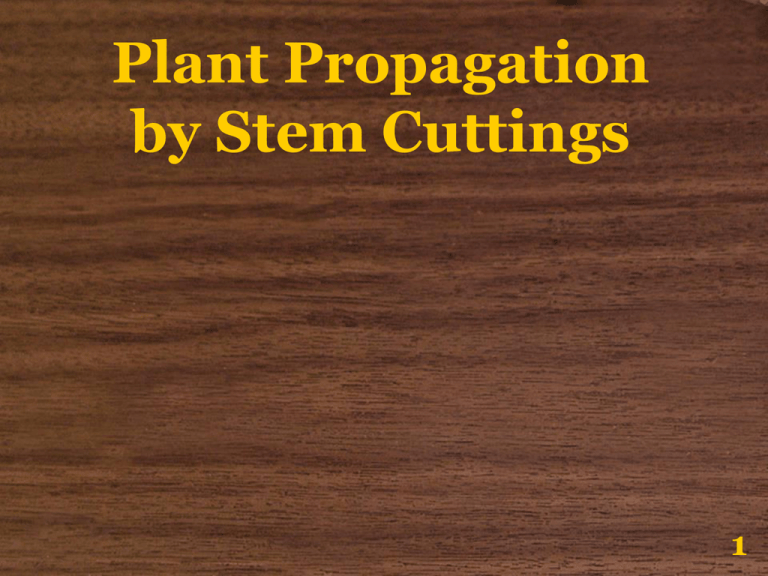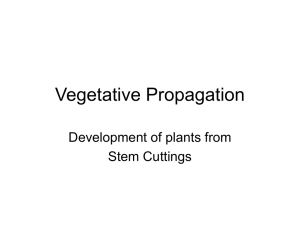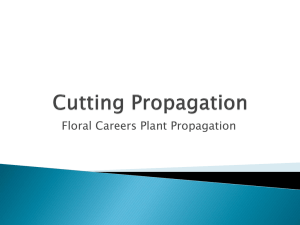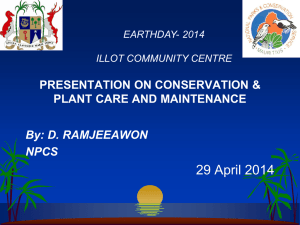Presentation
advertisement

Plant Propagation by Stem Cuttings 1 Cutting - Defined Any detached plant part which, when placed under favorable conditions, will produce a new plant identical to the parent plant. 2 Types of Stem Cuttings Segments of stems containing buds are used to produce new plants. There are several types: • Softwood • Semi-hardwood • Hardwood • Herbaceous 3 Types of Stem Cuttings (continued) Softwood cuttings are taken from woody plants when growth is still relatively soft and succulent before tissues have matured and become woody. 4 Types of Stem Cuttings (continued) Semi-hardwood cuttings differ from softwood cuttings only in the maturity of the wood. They are collected later in the growing season when the lower portion of the cutting has become lignified (woody). 5 Types of Stem Cuttings (continued) Hardwood cuttings are taken in the dormant season when tissues are fully matured and lignified through their entire length. This may be after leaves have dropped in deciduous species. 6 Types of Stem Cuttings (continued) Herbaceous cuttings are made from succulent, herbaceous (non-woody) plants such as geraniums, chrysanthemums, coleus, and carnations. 7 Procedure • • • • • • • • Gather Materials Prepare Rooting Media Remove Cuttings from Stock Prepare Cuttings Apply Rooting Hormone Place Cuttings in Media Label Cuttings Follow Proper Safety and Sanitation Procedures 8 Materials Rooting Medium Cutting Stock Rooting Non-Water Hormone Soluble Marking Utensil Spoon Labels Cup Pruning Shears Liquid Rooting Hormone 9 Preparing the Rooting Media 10 Many types of media may be used for rooting beds including sand, perlite, pine bark and vermiculite or a combination of these products. Vermiculite, shown here, makes a good rooting media because of its coarse texture, sterile nature and water and air holding capacities. 11 Rooting media should be firmed so cuttings make good contact with the media and to eliminate large air pockets. Firming can be accomplished with clean hands, a piece of wood or by tapping the container on the bench. The media should also be thoroughly moistened. 12 Vermiculite is a mineral that has been exposed to high heat and expanded – sort of like popcorn. Its coarse structure is an asset. Be careful not to pack it or crush it, thus destroying its structure. 13 Removal of Cuttings 14 Many propagators take large pieces of stock from the field and move to an indoor location for final cutting preparation and sticking. In this case, place cuttings in a plastic bag and keep the cuttings out of the sunlight. 15 Keep cuttings cool and moist if they are not used immediately. An ice chest with a small amount of ice performs this function well. 16 Select quality stock. Avoid stems with flowers and berries. 17 Make a basal cut just below a node at a 45 degree angle. 18 Make maximum use of stock provided by taking multiple cuttings from one branch. The top cuts are sometimes called stem-tip cuttings while the cuttings made below the top are called medial cuttings. 19 Cuttings should be 3” to 6” long, and uniform in size, although larger or smaller cuttings are used in certain situations. Cutting size is limited because the top of the cutting must be supported by the limited amount of moisture that can be absorbed through the base until rooting takes place. 20 Uniformity of a nursery crop is very important from a marketing standpoint as well as obtaining a uniform, healthy look when plants are installed in the landscape. Uniformity begins in the propagation bed. 21 Preparation of Cuttings 22 Remove the bottom leaves from the cuttings. Leaves placed under the soil or in direct contact with the media may rot and cause disease. 23 Cuttings of harder-to-root plants are often wounded to expose more cambium and increase the chances of rooting while decreasing the time required to root. 24 Identify the tops of deciduous cuttings so that the cuttings are not turned upside down in the rooting media. Often times this is done by cutting the top of the cutting at a 90 degree angle and the bottom of the cutting at a 45 degree angle. This allows polarity to be observed. Bottom Top 25 The leaves of large-leaved cuttings may be trimmed before sticking to conserve propagation space. 26 Application of Rooting Hormone 27 The application of rooting hormone often promotes production of a new root system. 28 Measure a small amount of powder into a separate container to avoid contamination of the entire supply. 29 Treat multiple cuttings at the same time. 30 Tap off the excess hormone powder. Be sure that the portion of the stem that will be under the media is coated. 31 If using liquid hormone, hold cuttings in liquid for a full 5 seconds. (Count 1001, 1002, 1003, 1004, 1005.) 32 Placement of Cuttings in Medium 33 Make holes in the growing media with a label or other clean tool. 34 Cutting a furrow in the growing media is also acceptable. 35 Place cuttings into the media 1 to 2 inches deep. Hold each cutting with your fingers at the desired depth and push the cutting into the prepared hole or furrow until the desired depth is reached. Placing all cutting at the same depth helps in establishing uniformity. 36 Gently firm the soil around the base of the cutting to hold the cutting in place, to eliminate air pockets, and make sure the base is in good contact with the moist media. 37 The cuttings can also be firmed using a label or other clean tool. 38 To test for proper firmness of the media around the base of the cutting, give a light tug on the cutting. If the cutting slips easily from the media with little resistance, the cutting was not firmed properly. 39 Cuttings should be spaced in the rooting media to allow for efficient use of propagation space. 40 Rows should be evenly spaced with little overlap of leaves to help prevent disease. 41 Cuttings placed too close together, with overlapping leaves, hold moisture and prevent air circulation, allowing disease organisms to thrive. 42 Labeling Cuttings 43 Using a non-water soluble marker, prepare a label with scientific name, cultivar, common name and date. Additional information for the label may include hormone treatment and name of the propagator. 44 Place the label in the container with the plant name facing out for easy identification. 45 One final step is to water-in the cuttings to settle the rooting medium around the base of the cuttings. Following watering, the cuttings should be placed on a mist bed to ensure proper moisture levels are maintained. 46 Safety and Sanitation Procedures 47 NEVER cut toward hand or fingers! 48 Pruning shears should be closed when not in use. 49 Proper sanitation is essential to prevent disease. Alcohol or a 10% bleach solution may be used. 50 Discard remaining rooting hormone to prevent the spread of disease. DO NOT contaminate the main supply by returning used hormone to the original container. 51 DO NOT use cutting materials that are dropped on the floor. The dropped materials may become contaminated with disease and infect the entire crop. Keep work areas neat, clean and free of debris. 52 Attention to detail is important when propagating nursery stock. Following proper procedures in all aspects will ensure a healthy, uniform and marketable crop. 53 Summary 54 Prepare Rooting Media • Select a rooting media with good water and air holding capacities. • Prepare the media by moistening and firming it into the selected container. • Take care when working with vermiculite – do not crush the material. 55 Removal of Cuttings • Take large pieces of stock from the field to an indoor location for preparation and sticking. • Keep stock cool and moist if it is not used immediately. • Select the best quality stock. Stock with berries or flowers should be avoided. If necessary, remove flowers and berries. • Cuts should be made cleanly using a sharp pair of pruning shears, just beneath a node. • Maximize the plant stock provided. • Trim cuttings to between 3” and 6” in height. All cuttings should be of uniform height and size. 56 Preparation of Cuttings • Trim the leaves from the bottom ¼ to 1/3 of the cutting. • Wound or scar the cuttings. • Observe polarity by cutting the the top of the cuttings at a 90 degree angle and the bottom at a 45 degree angle. • Trim the leaves of large-leaved species. 57 Application of Rooting Hormone • Application of rooting hormone promotes the production of a new root system. • Prevent possible contamination by measuring a small amount of hormone powder into separate container before treating cuttings. • Treat multiple cuttings at the same time in powder or liquid rooting hormone. • Tap off excess powder before placing in rooting medium. • If using liquid rooting hormone, hold in the hormone for a full 5 seconds. 58 Placement of Cuttings • Make a hole or furrow in the growing medium to accept the cutting. • Place cutting into the hole or furrow to a depth of 1 to 2 inches. • Gently firm the soil around the base of the cutting to hold the cutting in place and eliminate any air pockets. The cuttings can also be firmed in using a label or other clean tool. • Test for proper firmness by giving the cutting a light tug. • Cuttings should be evenly spaced in the propagation media. 59 Labeling Cuttings • Using a permanent marker, make a label with the scientific name, cultivar and common name and date. Additional information for the label may include hormone treatment and name of the propagator. • Make sure the label is neat and legible. Place the label where it can be readily seen and read. • Water-in the cuttings and place on a mist bed. 60 Safety and Sanitation Procedures • Avoid cutting toward hands and fingers. • Pruning shears should be closed and locked when not in use. • Tools and materials should be properly sanitized to prevent the spread of disease. • Excess rooting hormone should be discarded. • The work area should be kept neat, clean and free of clutter. 61 Teacher Notes The following three slides contain the teacher notes for this presentation. They can be printed for reference or viewed in the notes/normal view of PowerPoint. Home Next Slide 62 Title Slide: This presentation gives the definition of a cutting and illustrates the process of propagating a softwood stem cutting. Slide #3: The type of cutting depends on the propagator’s circumstances, the time of year and the plant to be propagated. The following is a list of ornamentals which are readily propagated from cuttings: Abelia, Azalea, Barberry, Boxwood, Hydrangea, Cotoneaster, Elaeagnus, Flowering Quince, Gardenia, Holly, Honeysuckle, Camellia, Juniper, Euonymus, Forsythia, Pyrancantha, Rose, Spirea, Viburnum, Crape Myrtle. Additionally, several plants are difficult, if not impossible to propagate from cuttings. These include fir, pine, hemlock, redbud, ginkgo, mountain laurel, spruce, Southern magnolia and dogwood. Most common shade trees such as oak and elm are also difficult to propagate from cuttings. Slide #4: Softwood cuttings usually root easier and faster than other types of stem cuttings, taking about 6 weeks. Softwood cuttings should be taken during the summer months when plants are still growing. The stems should be hardened enough to “snap” when bent. Slide #5: Semi-hardwood cuttings of evergreen species are generally taken from new shoots 6 to 9 weeks after a flush of growth when the wood is partially matured. This can be any time from mid-spring to the end of the growing season. Slide #6: Cuttings should be planted upright with the top 2-3 buds above the medium. Hardwood cuttings vary in length from 4 to 20 inches with at least two nodes included in the cutting. The diameter of the cutting may range from ¼ to 1 inch depending upon the species. Slide #7: Herbaceous cuttings are typically3 to 5 inches in length with leaves retained at the upper end. Most florists’ crops are propagated by herbaceous cuttings. 63 Slide #9: Note to teacher/presenter: When viewing the slide show, clicking the mouse once will start the animation of this slide. The names of each of the following items will appear one second after the previous. Several materials are necessary to propagate cuttings: Rooting Medium – such as vermiculite or coarse sand mixed in a 1:1 ratio with peatmoss. The media should be sterile to help the cutting avoid disease infections. It should also be low in fertility, drain well enough to provide oxygen, yet retain enough moisture to prevent water stress. Spoon – for measuring rooting hormone Permanent Marker – for marking labels Rooting Hormone – such as RooTone or Dip ‘n Grow Cup – to place rooting hormone in Pruning Shears – for making cuttings and wounding Labels – to mark name and date of cuttings Slide # 17: Flowers and berries consume much of the food stored in and produced by the cutting – nutrients which would otherwise be used to produce a new root system. Slide #24: The purpose of wounding cutting is to remove a portion of the bark layer to expose the cambium. New roots will be formed in this area. Wounding is generally done on harder to root woody plants. One method of wounding is to remove a thin layer of the bark from the base of the cutting one half inch to one inch long with a knife or the blade of a shear. This may be done on one or more sides of the cutting. 64 Slide #25: Explain the meaning of Polarity to the students. Polarity is a common phenomenon in most organisms. The word Polar implies to things which are at the opposite ends of an axis. The North Pole and the South Pole are at the opposite ends of an Axis drawn through the center of the Earth. Most plants are polar. The root and shoot are typically the "poles" we visualize when we think about plants. We can also visualize the Shoot tip and the Shoot base as opposite ends of the shoot axis. The same applies to roots, and other organs which are polar. Slide #31: It is important to tap off the excess powder because a thick coating of rooting hormone will burn the tissue of the cutting. Slide #34: A hole or furrow must be made in the growing media in order to insert the cutting. This is necessary so the rooting hormone previously applied to the cutting will not be knocked off when placed in the medium. Slide #4o: Propagation space is expensive. Cuttings must be placed close enough together in the media to make efficient use of the space but spaced far enough apart to allow good air circulation and drying of the foliage and stems to prevent disease. Slide #46: Care must be taken when watering-in to make sure the cuttings are not dislodged. Slide # 50: Tools can be sterilized by soaking is a disinfectant such as rubbing alcohol, a diluted bleach solution (dilute 1 part bleach to 10 parts water) or boiling water. Disease picked up from one cutting can easily be spread to the cut area of all other cuttings. Slide #52: Propagation areas, especially the floor, of nurseries are a great place for plant diseases to thrive. The area should be kept clean and disinfected often. Dropped cuttings placed in the propagation flat may infect the entire crop. Home 65 Ms. Holli Bowman is a master’s graduate of the Agricultural Education Program at the University of Georgia. She will begin teaching Horticulture at North Hall High School in the Fall of 2002. Dr. Frank Flanders is the Curriculum Coordinator for Georgia Agriculture Education. He and his staff produce the Georgia Agricultural Education Curriculum Resource and Reference CD annually. Home 66








